
Omega Speedmaster Apollo 8 311.92.44.30.01.001 [Guide & Review]
The Omega Speedmaster Apollo 8 is a fun, interesting, and different watch in Omega’s collection.
Omega has been pushing its relationship with Nasa and space missions for a long time now. And unarguably, the marketing Omega is doing to promote its relation to the space missions has worked.
Over the years, Omega has also released countless special edition Speedmaster watches so that it is difficult to even keep track of them all. With that said, Omega is great at taking advantage of history to create either a new special edition Speedmaster or simply to push an existing one to its customer group.
Originally, the Speedmaster was a model which was meant for racing: a race watch. But when the space projects started, Omega became the only watch approved by NASA for space flights. And Omega has never looked back ever since.
In 1968, the Apollo 8 crew became the first humans to ever see the dark side of the moon. 50 years later, in 2018, Omega produced a new timepiece to celebrate this event. It may not come as a surprise that as a base, the watch is a Speedmaster. But as a matter of fact, the Speedmaster Apollo 8 is something quite special, and far from your ordinary Speedmaster Moonwatch professional.

The Speedmaster Apollo 8 is bold yet intriguing and has come to become a very popular model from Omega du to its immense attention to detail and, as a matter of fact, unique design.
In this article, we’re looking closer at the Omega Speedmaster ”Dark Side of the Moon” Apollo 8 reference 311.92.44.30.01.001.
Omega Speedmaster ”Dark Side of the Moon” Apollo 8 311.92.44.30.01.001
Now, as mentioned, Omega is great at riding the ”moon watch” wave. They’ve released countless special edition timepieces to commemorate or celebrate different events during the space projects. And the fact is that many people believe Omega is pushing the NASA space relationship a little too much.
But regardless, we can still think watches are objectively beautiful, nice, and special, even though we don’t like the promotion behind it.
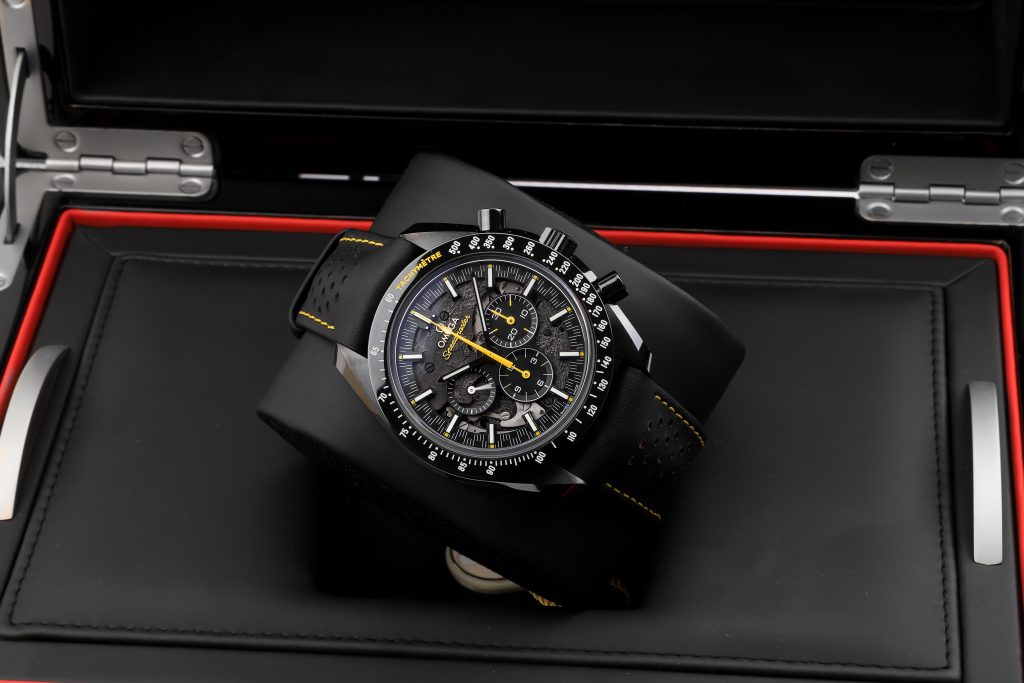
So what is the story behind the Speedmaster Apollo 8? As you can tell by the name, this special edition is made with Apollo 8 in mind.
What is Apollo 8?
Apollo 8 was the second crewed spaceflight mission flown in the United States Apollo space program and became the first crewed spacecraft to leave low Earth orbit, reach the Moon, orbit it, and return. Furthermore, the crew of Apollo 8, which launched December 21, 1968, were the first to see the far side of the Moon, and in honor of the first time that humans circled the Moon, Omega created a special Speedmaster hybrid called the Moonwatch Apollo 8 ”Dark Side of The Moon”.
Apollo 8 saw not only the dark side of the Moon but also Earthrise. And this mission helped to prove the viability of putting a man on the Moon.
Now to the watch. Suitable for the watch’s name, the watch is almost completely black. At its core, it is actually the same case as the regular Dark Side of The Moon, but it’s the dial and movement that makes this watch something truly special.
Characterized by bright yellow details, polished and matte/brushed black, and with a detail-rich dial and movement, the Speedmaster Apollo 8 is both bold yet discreet. And it offers impressive attention to detail.
The case
As the name suggests, the Apollo 8 actually uses the same black ceramic case as the standard Dark Side of the moon. It is 44.25mm wide, 12mm thick, and 49mm lug to lug.
Whilst it is a wide case, the 12mm thickness of this hand-wound movement is well matched by the lug-to-lug length. (Total case thickness of 13.8 mm.)
The watch is big but absolutely wearable. This is also contributed by the short lugs which don’t stretch too far out on the wrist.
The case has the iconic-for-Omega twisted lugs which you can find on many of Omega’s watches. And most importantly, have been iconic to the Speedmaster range for a long time. In order to give a brushed effect on the side of the ceramic case, Omega has had to use diamond-tipped tools. And this combination of brushed and polished on a case made of ceramic is truly impressive.

More specifically, this watch is made in jet-black zirconium oxide ceramic, with a polished ceramic tachymeter bezel, matched with satin elements.
The watch has a see-through sapphire case back from which you can admire the movement. On the case back is also engraved “WE’LL SEE YOU ON THE OTHER SIDE” which is a reference to Jim Lovell’s final words spoken to ground control just before Apollo 8 traveled to the far side of the moon.

A theme of the Apollo 8 is its black colors contrasted by a bright yellow, which is a combination that works extremely well. The tachymeter scale also contains luminous material, which enables excellent readability of the tachymeter scale in the dark.
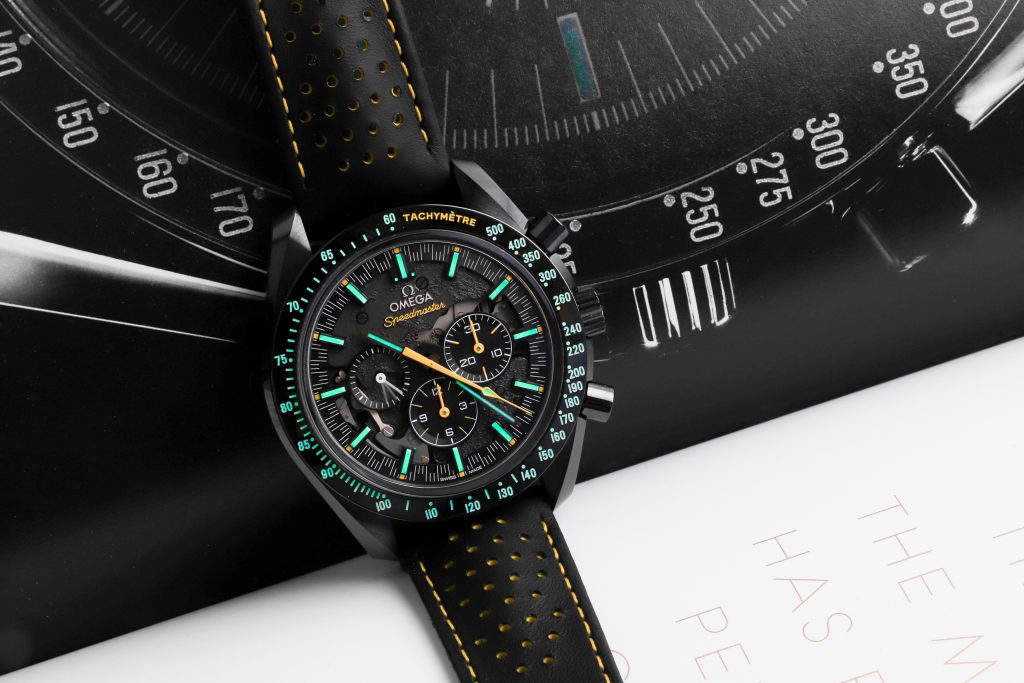
The chronograph hands are varnished yellow, while the watch’s tachymeter scale and crown are filled with white Super-LumiNova. The Speedmaster and Tachymetre words also appear in yellow.
The plunger-style chronograph pushers are made in polished black ceramic and rounded on the top for comfort. The pushers demand a rather firm push to engage the chronograph and halt it with the top pusher and to return the yellow, arrow-tipped chronograph seconds hand to zero with the bottom one.
The Omega Speedmaster Apollo 8 comes on a perforated black leather strap with yellow rubber through the middle. The strap has a tang buckle, which also happens to be made of black ceramic. As you would expect, the strap is really comfortable and getting closer to the case, the strap gets thicker in order to offer more support to the wrist.
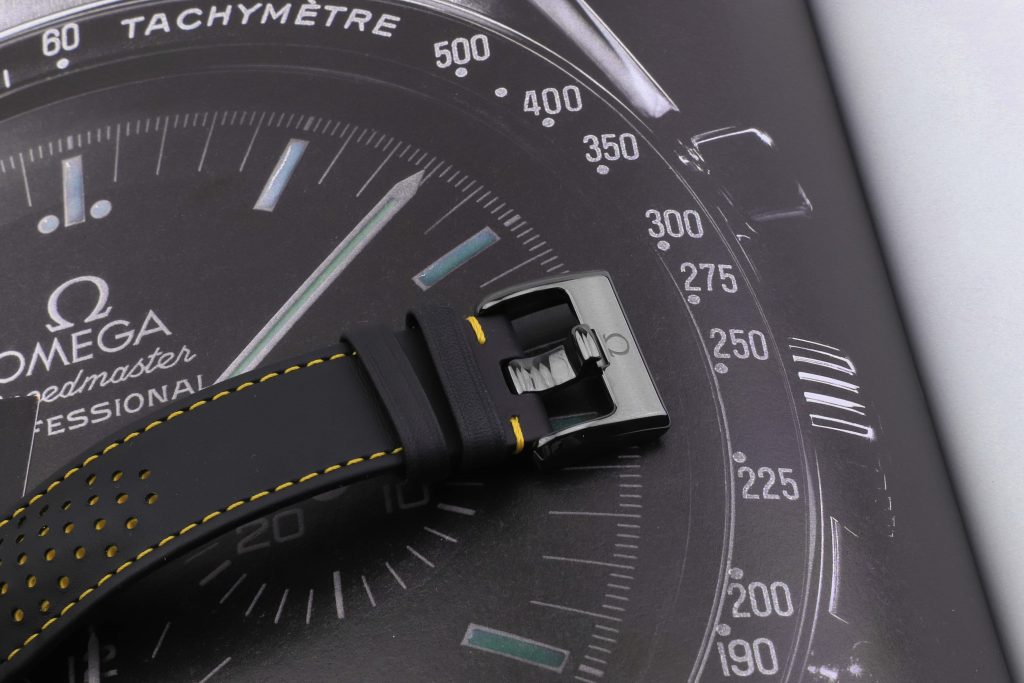
The movement
Now, let’s talk about the perhaps most important part of the Omega Apollo 8, and that is the movement, which in a way also can be referred to the dial because of the way it is crafted.
The Apollo 8 has a see-through case back. But it also has a semi-see-through dial.
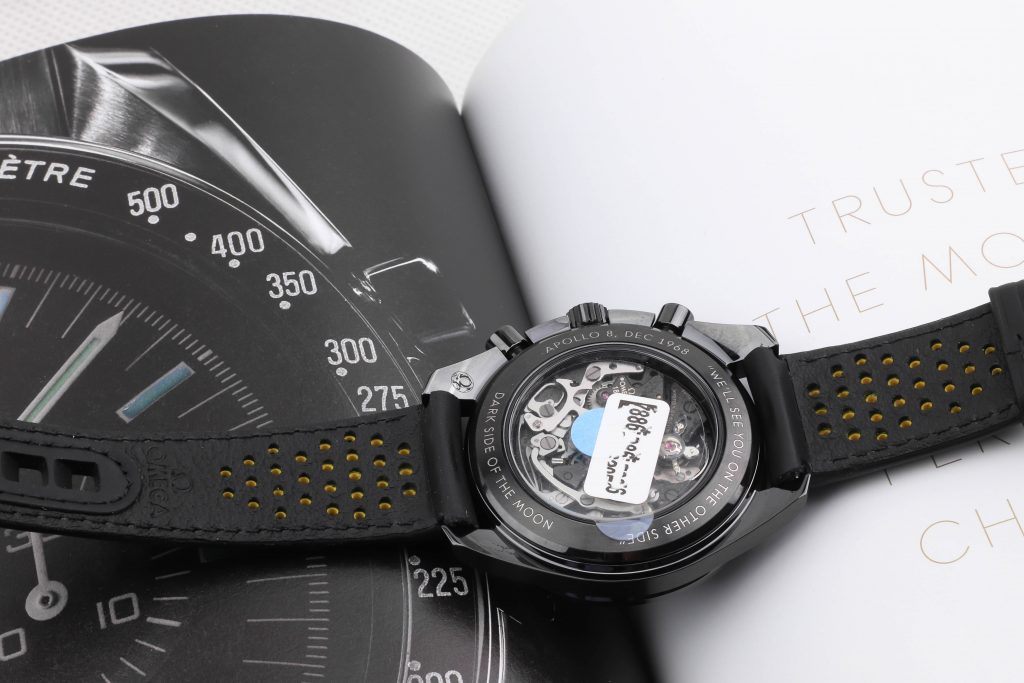
The watch is powered by the hand-wound caliber 1861. This is an interesting choice of movement as Omega otherwise uses the advanced co-axial movement in the Dark Side of the moon watches, usually calibre 9300. It is interesting because Omega instead uses a legacy Speedmaster movement in the Apollo 8 which is a fun nod to the Speedmaster Professional as the original Moonwatch and to make a modern timepiece with a historic movement.
The 1861 is not as technically advanced as the 9300 common to the Dark Side lineup, but for most people, its history weighs it up.
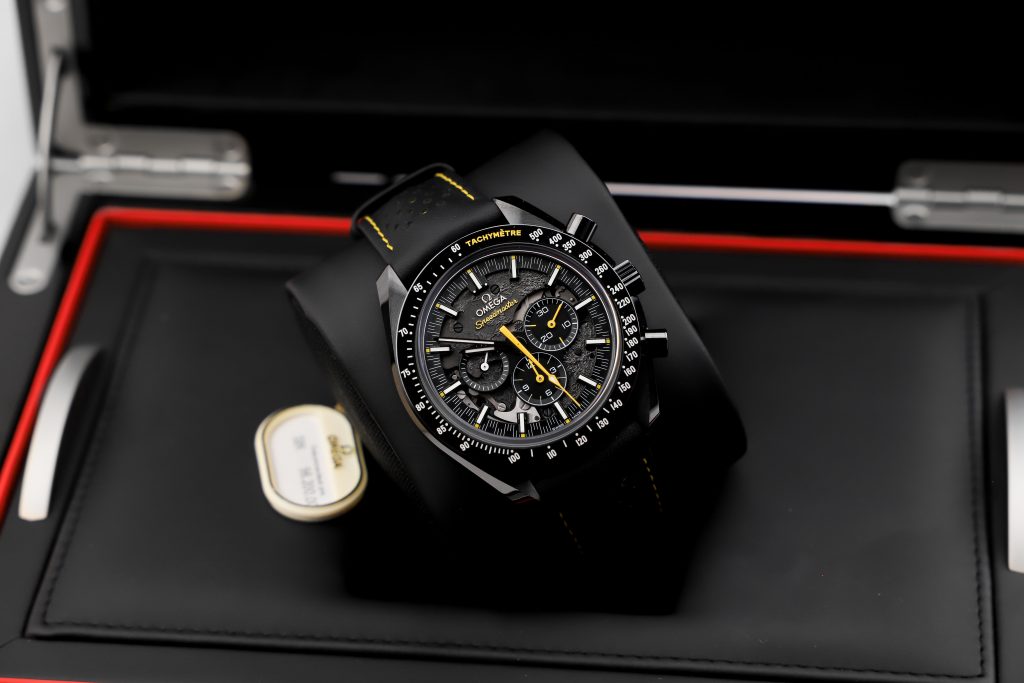
Furthermore looking at the movement, it’s absolutely stunningly decorated, so there’s not a lot to complain about here.
The dial of this watch is what makes it, as its details are simply impressive. The dial has been laser-treated in order to create a surface similar to the moon. Omega has used laser ablation on the plates and bridges to create a lunar-surface effect. In some places, behind the chopped-up dial parts, you can see through the watch. You can also see some parts of the movement.
The level of attention to detail and texture in the moon’s surface on the dial is simply impressive, and this is really what makes this timepiece.
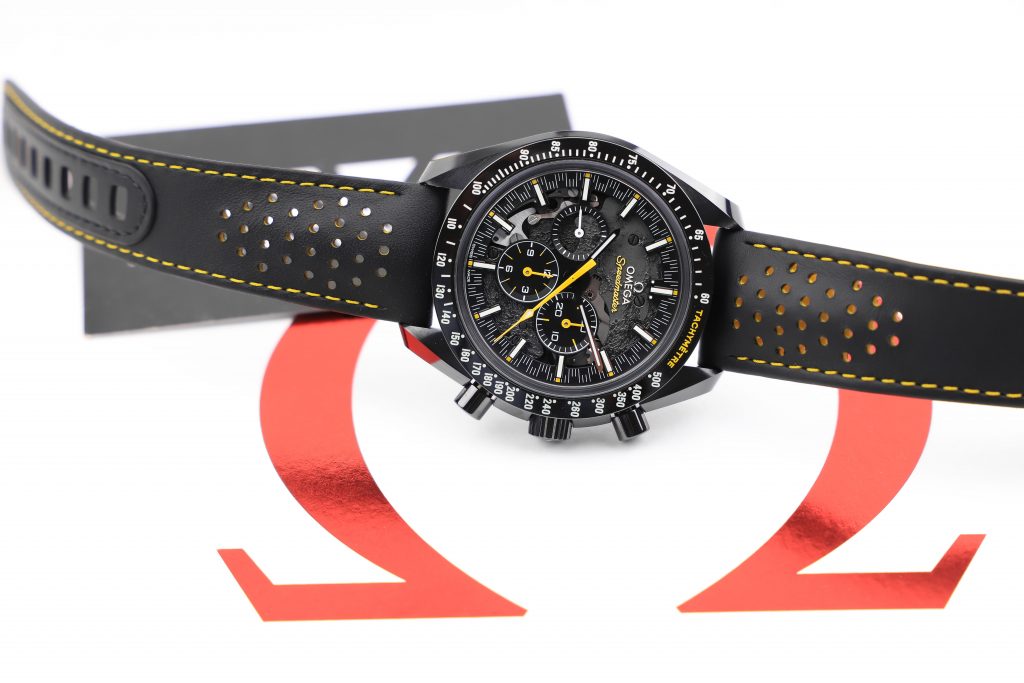
If you flip the watch over, you are able to admire the beautifully decorated manual-wound movement. Through a sapphire crystal on the case back, you will see bridges finished to match the lunar-like details of the dial to continue on the theme of the dial. The movement is a mix of dark textures, purple jewels, and the varied brightwork of metal cams and wheels.
Surprisingly, this black watch offers great legibility. The dial of the watch has relatively large white markers. Also, the sub-dials feature a necessary level of yellow color which enabled great legibility there.
If you are using the chronograph, you’ll have no problem seeing the hand as it is also finished in yellow.
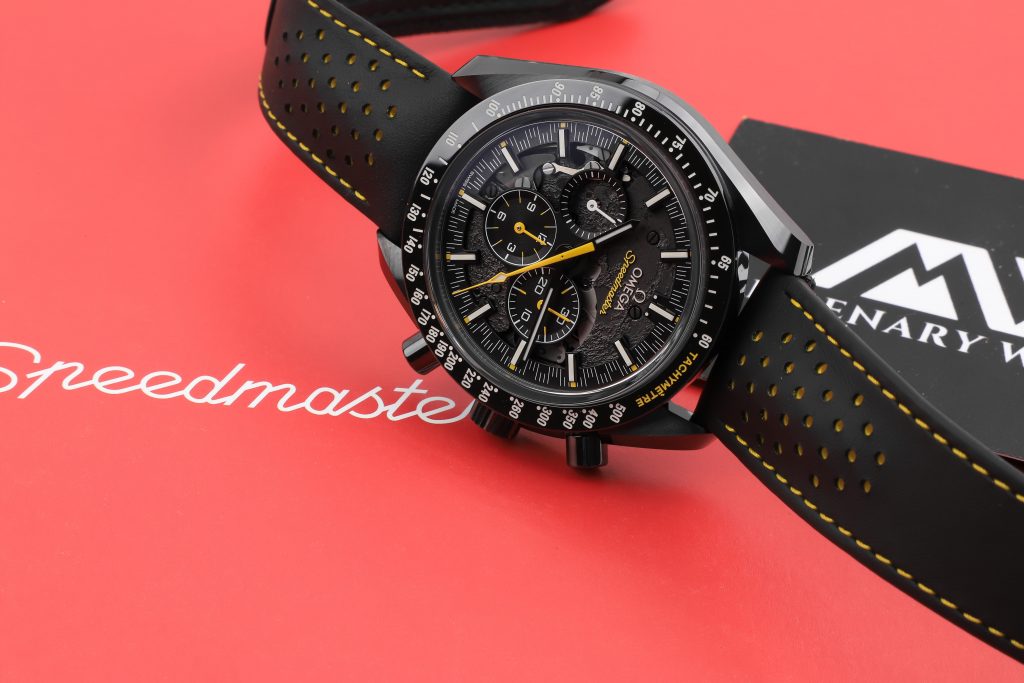
There’s a risk with this kind of timepiece – all-black and with bold colors such as yellow that they come off as a bit too childish and ”unprofessional”, but the Speedmaster Apollo 8 just pulls it off. The yellow elements are subtle enough to not stand out, while the impressive details on the dial contribute to an interesting level of depth and seriousness.
Further thoughts about the Speedmaster Apollo 8
When it comes to the Apollo 8, it’s really the details of the dial that makes all the difference in the world. The level of detail is simply astonishing.
What may be surprising is the fact that the Apollo 8 is actually cheaper than all other Dark Side Of The Moon models. This most likely has to do with the use of a cheaper movement, but also because the Apollo 8 (probably) is more niche than the regular DSOTM.
When putting the watch on the wrist, the Apollo 8 feels really good. The first reaction is its weight. Being made of ceramic, this watch weighs almost nothing. On the same note, the short lugs make this watch wear almost like a 40mm as opposed to 44.25mm which is its specified diameter.
In terms of thickness, the Speedmaster Apollo 8 is no problem. The case back is quite flat, which is always a bonus as it allows the watch to sit slimmer on the wrist.
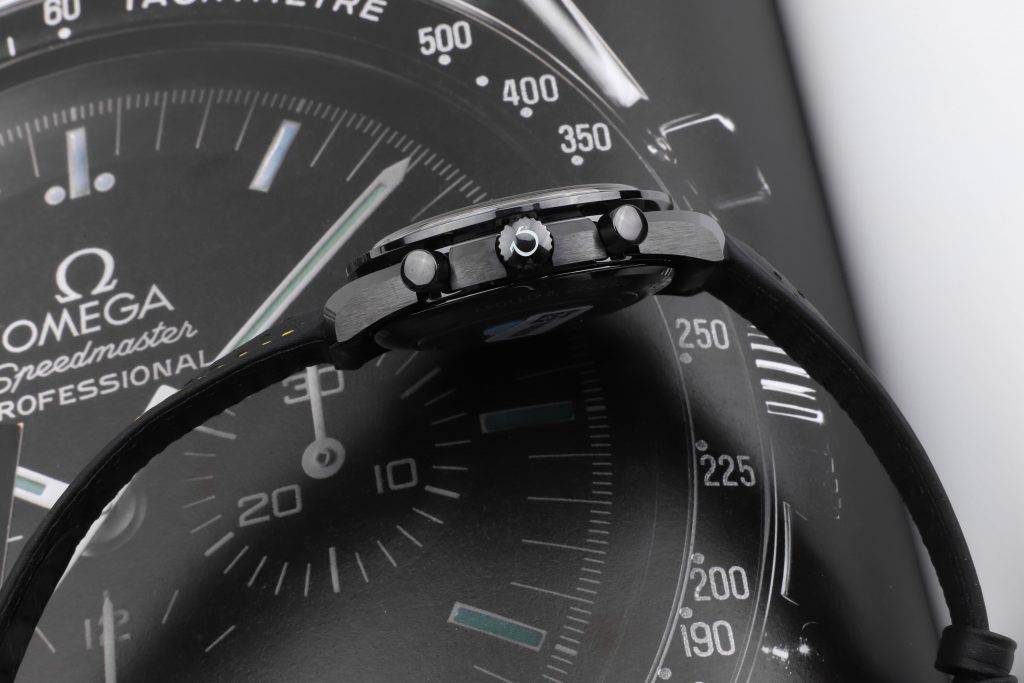
In terms of the case, ceramic is extremely good as it is essentially scratch-proof. This means you don’t really have to worry about getting scratches. But at the same time, ceramic can shatter, and this would mean having to replace the whole watch, which isn’t going to be cheap.
So just make sure you don’t drop the watch and it will look just like new no matter how much you use it.
Talking about ceramic, this is a trend that has grown stronger and stronger over the years in the world of horology. Today, there are plenty of ceramic choices. And so the question is, does the Apollo 8 stand up against its competition?
Some of the ceramic competitors include Omega’s own standard Dark Side of The Moon, the Tudor Fastrider Black Shield, IWC Topgun ceramic, Zenith Defy Chronograph, Hublot ceramic, and in recent times, Audemars Piguet has also started making ceramic watches.
Safe to say, the competition among ceramic watches is actually quite tough.
But if you’re a fan of the Speedmaster, its history, and the whole history of the space program, the Speedmaster Apollo 8 might just be a watch for you. Because you can say a lot about the Apollo 8, but you cannot say that it isn’t well-made.
And frankly, because the Apollo 8 is a watch that has dared to spread its wings and try something completely different, there’s no direct substitute. The closest would be the standard Dark Side Of The Moon, even though they are perceived as two completely different watches. Furthermore, the Apollo 8 is inevitably a quite niche watch within the Speedmaster range. At the same time, the closest to the Apollo 8 is the Dark Side of The Moon, and surprisingly, this watch is actually priced higher.
The Apollo 8 started from the DSOTM concept and then added to the model to make it more interesting and appealing. And whether you like the watch or not, you can absolutely say that they have succeeded. The Apollo 8 is fun, unique, and different. It is a nod to the era of space missions when Omega was the only obvious watch of choice.
What is also great is that Omega has made countless different special and limited editions celebrating the different apollo. But many of these editions are simply regular Speedmasters with a slight difference in the dial such as a print or logo. But the Apollo 8 is not like that. yes, it is based on the DSOTM, but it has more so started from scratch with the design, and this also makes it so much more interesting than many special editions Omega watches out there.





Hi
I have this watch and love it but it does not read in the dark….is there something I am missing?
Hi Louis,
Congrats on a beautiful watch!
Have you tried charging it with light first? For example with a flashlight or a UV-light?
Kind regards,
Millenary Watches